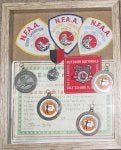Aluminum arrows right out of the box are pretty darned straight. They get bent pretty easily and pretty dramatically if you miss the target and hit the wooden target frame. (Don't ask me how I know this.) But has anyone with an arrow straightness tester (one of those things with a dial indicator that can detect runout) ever tested aluminum arrows after they have been shot into a target a few times? -- in other words, arrows that have not been abused by shooting them into hard objects? The arrow is going to deflect (bend) when it hits the target. Most people assume that this ordinary target practice will not produce a permanent bend in the aluminum shaft, but is that correct? A lot of folks are pretty sensitive to the difference between having arrows with a straightness tolerance of, say, .002" and arrows with a straightness tolerance of .006", and they think that degree of straightness difference is important. The difference of .004" is small and difficult to see. (.004" is about 1/3 of the thickness of a playing card. ) Is it possible that those .002" straightness aluminum arrows turn into
006", .008" or .010" after they get shot into a target a couple of times?
006", .008" or .010" after they get shot into a target a couple of times?














